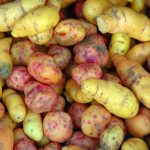 A swollen part of an underground stem, e.g. potato.
A swollen part of an underground stem, e.g. potato.
A thickened branch of an underground stem, serving as storage organ, distinguished by bearing leaves/leaf scars and axillary buds;
A swollen root or branch of a root acting as a reserve store of nourishment or water (root-tuber).
A stem, usually underground, enlarged as a storage organ and with minute scale-like leaves and buds or “eyes”.
Swollen underground stem, such as produced by Dahlias and Potatos, which can sprout and produce new plants.
A thickened fleshy outgrowth of an underground stem bearing numerous minute leaves with bulbs (“eyes”) in their axils, from which new plants may arise. An example is the potato.
A short, fleshy, underground part of a stem or root. (Example: potato, Western Peony, Jerusalem artichoke and White or Irish potatoes)
A swollen part of an underground plant stem of one year’s duration, capable of new-growth.
A fat, starchy underground organ designed to store food for a plant during its dormancy. Many tubers, such as those of the potato, provide food for humans too.
A swollen, starchy underground organ designed to store food for a plant during its dormancy. Many tubers, such as those of the potato, provide food for humans too.
A thickened or swollen part. The tuber cinereum is a part of the brain situated at the base of the hypothalamus, connected to the stalk of the pituitary gland.
An enlarged part of a root or underground stem. The potato is perhaps the most familiar tuber.
